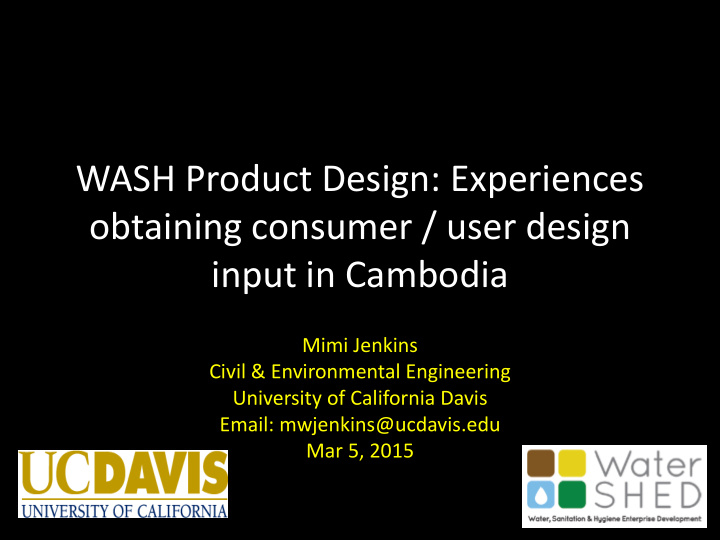



WASH Product Design: Experiences obtaining consumer / user design input in Cambodia Mimi Jenkins Civil & Environmental Engineering University of California Davis Email: mwjenkins@ucdavis.edu Mar 5, 2015
Design Thinking 1. What do people want Business and need? (viability) (Desirability) 2. What is technically People Technology (desirability) (feasibility) possible to produce and sell? (Feasibility) Design thinking 3. What is financially possible for local businesses? (Viability) SOURCES: Chapin and Pedi (2013) Getting the Product and Service Right. Guidance Note 5, UNCEF Sanitation Marketing Learning Series. Gates/IDEO (2009) Human Centered Design Toolkit.
Approach used in Cambodia for designing HW devices and IYC FM products Step I: Assess & understand user context, current practices, & needs Rapid purposeful survey of current practices, existing equipment, and perceptions of target users Step 2: Use ‘sacrificial’ prototypes to find out what people want, would buy, & why Global + local inventory of relevant product designs, key feature variations Extended consumer trials of physical prototypes (or FGDs with product samples / prototypes)
Handwashing Device Design Study: Equipment preferences of rural Cambodians
Step 1 Survey • 10 purposefully selected villages • 79 randomly selected households • Interview and HW demonstration with adult female child caretaker
Typical Handwashing Practice & Equipment in Study Villages Filling a basin or bowl with water from an outdoor storage jar using a dipper or bowl, immersing hands into the basin to wash and then re-filling the bowl from the storage jar, often several times, to rinse, while squatting near the storage jar.
Dedicated HW Equipment • Only 4 of 79 surveyed households had purchased dedicated equipment installed at fixed location – “to make handwashing easier”, “have all things for handwashing in one place” • 95% : no dedicated HW equipment or station
HW device interest & desired features • Relatively high levels of latent demand => 52% had thought about building or buying equipment to use just for handwashing • Desired equipment features: tap, soap holder and basin • Inspired by seeing handwash facilities connected to piped water at clinic/hospital, friends/relatives, on TV, and other away settings
Step 2: Extended consumer testing and trial of “ sacraficial ” prototypes • Conducted in 5 villages from survey – Device usability, likeability, preferences and potential for HW behavior change – 22 surveyed households, with children – 5 alternative device designs – Each household tested 2 devices, each for 1 week – Selective & intentional pairing of device assignments (more rural/remote vs more urban/exposed) – Option to purchase preferred device for $1 – In-depth debrief after week 1 and after week 2
Coleman
Tippy Tap
Bucket with tap attachment
Bucket with hose attachment
Bucket with Ladle attachment
20 L 15 L 10 L
Desired Water Delivery Mechanism & Features • Controllable Tap most desired & preferred by far • 80% testing Tap device purchased tap device over alternative (ladle, hose) • Ability to turn on/off & control flow valued • Consistent with Tap as most desired feature from survey • Tap provides functional and aspiration value • Adding a basin would be good
Desired Water Storage Container Attributes & Features • Highly durable, sturdy, for rough handling, outdoor installation • Rigidity & stability, empty or full, stay in place on surface, and during refill • Wide mouth opening, easy-to-remove lid, for easy refilling at storage jar • Minimum 15 L, up to 20 L, refill 1-2 times/day max • Strong handle for easy refill carrying • Accommodate child refilling • Place on surface, dislike of hanging • Transparency – secondary desire
Tippy Tap Perceptions • Compared to old method, seen as improvement (week 1) • Compared to other devices, and when tested second, seen as inferior to other designs • Difficulty operating foot mechanism • Narrow container opening difficult for refilling • Higher frequency of daily refilling (small volume) • Low container durability • Difficult for children to operate alone
Trial Device Purchase Rates Device Type Tested Purchased Coleman (tap) 10 3 (30%) Tippy Tap 6 1 (17%) Bucket w/ Tap 10 8 (80%) Bucket w/ Hose 10 5 (50%) Bucket w/ Ladle 8 4 (50%) Total 44 21
Concluding Thoughts • Multi-day trialing of physical prototypes allowed people to easily talk about what they liked /disliked and why, providing critical information and insights for design thinking • Trying two prototypes with intentionally contrasting features of interest (i.e. container attributes, water delivery mechanism) much richer, more detailed product design information • Extended consumer testing / behavioral trial of prototypes also provided evidence of behavior change potential and consumer value • Use FGDS if no time/$$ for extended consumer testing • Just first step of iterative DESIGN process!!
Design Thinking 1. What do people want Business and need? (viability) (Desirability) 2. What is technically People Technology (desirability) (feasibility) possible to produce and sell? (Feasibility) Design thinking 3. What is financially possible for local businesses? (Viability) SOURCES: Chapin and Pedi (2013) Getting the Product and Service Right. Guidance Note 5, UNCEF Sanitation Marketing Learning Series. Gates/IDEO (2009) Human Centered Design Toolkit.
Follow up Resources • Chapin and Pedi (2013) Getting the Product and Service Right. Guidance Note 5, UNCEF Sanitation Marketing Learning Series (on-line at UNICEF WASH resources). • Gates/IDEO (2009) Human Centered Design Toolkit (www.designkit.org) • www.WaterSHED.org, for Cambodia HW device design study reports, posters, and papers and Cambodia IYC FM product design
“LABOBO” THE HAPPY TAP in Vietnam SOURCE: www.waterhsed.org
Recommend
More recommend